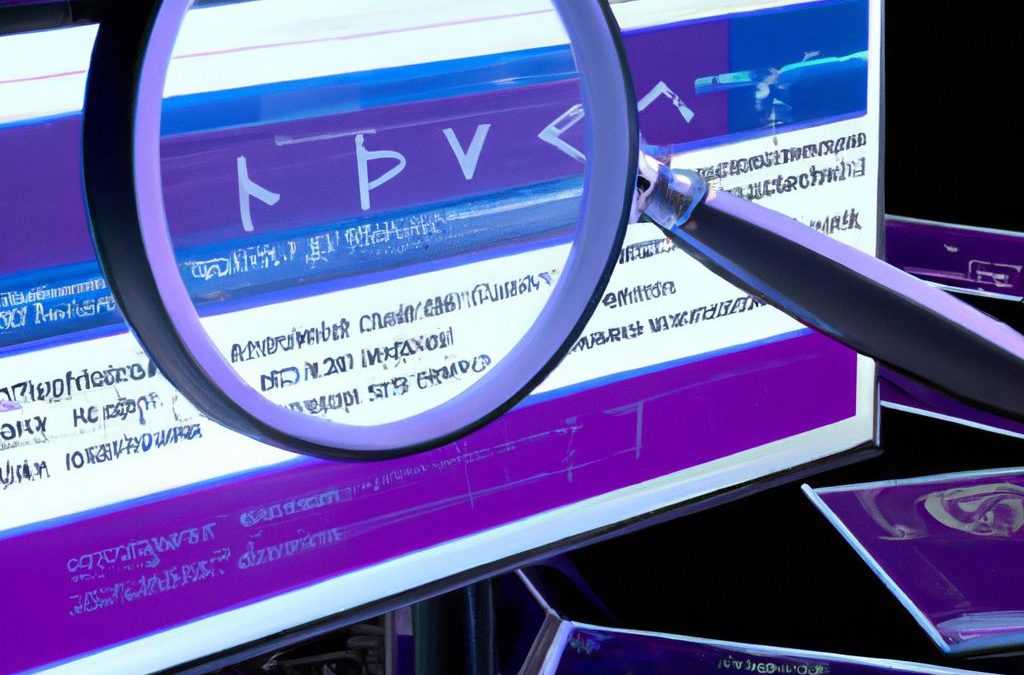Importance of Ad Verification in Advertising Monetization
Digital advertising is on the rise, and ad verification is key. Ad verification makes sure ads get to the right people, and on legit websites. Without it, publishers could lose money, and damage their reputation.
Ad verification tools provide essential info to stop fraud. They make sure ads reach the right users, not fake clicks or wrong demographics. So, it helps advertisers sidestep bad publicity, lost income, and damage to their brand.
In today’s digital age, even honest publishers can be taken in by bots and click farms. Ad verification is essential. It helps publishers keep tabs on fraud and build trust with advertisers.
One example: An ad campaign to Gen Z failed because of bot traffic. It was discovered the publisher was using a click farm. Both the advertiser and the publisher lost money. This case shows just how important ad verification is in preventing fraud.
Bottom line: Without ad verification, you’re playing with fire.
Need for Ad Verification
Ad Verification: Ensuring Brand Safety and ROI
Ad Verification is a critical aspect of digital advertising that helps advertisers ensure that their ads are reaching the right audience and appearing on appropriate websites. This process involves checking the content and context of ads and their placement to identify potential issues such as fraud, brand safety concerns, and ad misplacement.
Through Ad Verification, advertisers can ensure that their brand message is not associated with objectionable content or sites that go against their values or mission. This helps maintain brand reputation, customer trust, and ultimately, ROI.
Using sophisticated technology and data analysis, Ad Verification providers monitor various ad components and contextual factors such as the site’s content, audience demographics, and ad placement details to detect any potential issues. They also use machine learning algorithms to identify fraud or abnormal ad activity.
Although ad networks and advertising platforms have their own ad review processes, Ad Verification provides an extra layer of reassurance to advertisers. In a way, it acts as an independent auditor and monitors the entire advertising ecosystem, ensuring that the ad campaigns run smoothly and ethically.
Ad Verification has become an essential tool for brands and advertisers operating in the digital space. Its growth and relevance can be traced back to the increasing concerns over ad fraud, brand safety, and transparency in digital advertising. By understanding the importance of Ad Verification, advertisers can build stronger, more effective ad campaigns that protect their brand reputation and drive better results.
Why worry about ad fraud when you can just trust that Nigerian prince who promised to quadruple your investment in a week?
Ad Fraud and its Impact on Advertisers
Ad fraud is a menace that affects advertisers everywhere. It can cause millions of dollars in losses. Bot clicks and fake conversions are some of the tricks used by fraudsters, making it hard for advertisers to fine-tune their ad campaigns. Ad verification can help to detect and stop these activities.
Programmatic advertising has made ad verification more needed than ever. Advanced tech such as machine learning and AI are used by ad verification companies to monitor campaigns. They also provide advertisers with details about their traffic sources, simplifying the process of determining bad ones.
Advertisers should stay away from low-quality publishers to reduce fraud risks. Before partnering with a publisher, they must do research. Also, transparency must be demanded from partners and vendors regarding fees and charges. For better optimization, experienced teams knowledgeable about digital marketing technologies are required.
Types of Ad Fraud
Ad fraud is not a fresh concept, but with the rising popularity of online ads, the variety of ad fraud has grown. Click fraud is one of the most common forms, where bots generate false clicks or impressions to deceive advertisers. This results in wasted budgets and low ROI. Domain spoofing is another form, where advertisers think they are buying ads from popular sites, but really ads are shown on illegitimate sites.
Moreover, there are others like impression laundering, device fingerprinting, and cookie stuffing. Impression laundering occurs when advertisers buy traffic that looks valid, but it is made by bots or low-quality sources. Device fingerprinting tracks user data without permission and uses it for illegal activity. Cookie stuffing produces false data through unauthorized cookie placement.
To protect your brand, you should use verification tools to detect fraudulent activities. Ensure your ads are seen by genuine viewers on legitimate sites. Use trustworthy partners for ads and ask for transparency reports to verify where your ads appear.
Not verifying ads puts your brand in danger of low conversion rates, wastage of funds, and more. So, take steps before it’s too late! Not confirming your ads is like leaving your front door unlocked in a bad neighbourhood – you don’t know who will come in.
Role of Ad Verification
Ad Verification’s Crucial Role in Maximizing Advertising Revenue
Ad verification plays a critical role in ensuring that advertisements are performing as expected and meeting the advertiser’s standards. It helps publishers to maximize their advertising revenue by detecting and preventing fraudulent advertisements from appearing on their websites and apps.
Ad verification tools perform various functions such as detecting fraudulent activity, verifying ad placements, and monitoring viewability metrics. They ensure that the ads are delivered to the intended target audience while meeting the advertiser’s KPIs. Ad verification tools also provide valuable insights that can be used to optimize ad performance and improve user engagement.
It is essential to choose the right ad verification tools that are reliable, effective, and efficient in detecting and preventing fraudulent activities. With the right ad verification tools in place, the chances of revenue loss due to invalid activity, ad fraud, and brand safety issues can be significantly reduced.
For instance, a leading publisher, ABC News, was able to identify and prevent ad fraud with the help of ad verification tools. They increased their ad revenue by almost 20% and were able to identify fraudulent activity that was causing a significant revenue loss.
“Ad fraud gets me so mad, I might just click on every ad I see to teach those bots a lesson.”
Detection of Ad Fraud
Ad verification is key in detecting ad fraud. It ensures ads are placed on legit websites and reach the desired viewers. Fraudsters use complex tactics to avoid being detected, but modern tools can detect fraudulent behaviors by monitoring and analyzing data.
The first step in preventing ad fraud is by detecting it early. Ad verification checks for phony clicks, impressions, and suspicious activity on websites. This can be prevented and save ad spend if it’s caught quickly, improving campaign results.
AI-powered algorithms can be used to reveal ad fraud by studying user histories to determine if they’re real. Third-party verification services and website analytics software can also detect non-human traffic.
Before buying space from publishers, advertisements should be carefully examined. Brands are in danger if they don’t use trustworthy vendors that offer genuine info about advertised spaces.
To sum up, Ad verification tools have advanced for better analysis of digital ads, making fraud detection simpler than ever before. To avoid future damage, businesses must utilize all the above tactics to secure their campaigns against fraudulent activities that exploit their advertising budget and harm brand reputation. Protecting brand safety is like wearing a seatbelt – it may be limiting initially, but it could save lives in the end.
Maintenance of Brand Safety
Advertising has taken over the digital world, so brand safety is a very important goal for marketers. Ad Verification helps with this by scanning websites before ads appear – to check they meet advertisers’ requirements. This way, ads can avoid being next to inappropriate content or on fraudulent sites.
Ad Verification also monitors video and mobile campaigns in real-time. So if anything changes on a site after verification, the tools can detect it and take action.
To protect their reputation, marketers should use Ad Verification in their strategies. That way, they can be sure their ads are in the right places. Plus, ad verification can even boost ROI – no lucky charms needed!
Enhanced ROI
Investing in ad verification can lead to a higher return on investment. It does this by ensuring ads are seen in brand-safe environments and reach the right audience. Fraud prevention, viewability measurements, and contextual targeting all help with this.
This means brands can generate higher returns from their ad spend. Ad verification also helps protect brand reputation by only showing ads in suitable places. Plus, data analytics can help inform future campaigns based on customer feedback.
A MediaRadar report says 66% of US advertisers use ad verification services. That proves how important this tech is to maximize ROI.
Methods of Ad Verification
Paragraph 1: Ad Verification Techniques in Advertising Monetization
Ad Verification is an essential part of advertising monetization that ensures that an ad is seen by a real human audience, in a brand-safe environment, and as intended by the advertiser. Understanding the role of Ad Verification in digital advertising is critical for publishers, advertisers, and ad networks to maintain the integrity of their platforms and revenue streams.
Paragraph 2: Methods for Ad Verification
Ad Verification is performed using various methods that range from manual checks to advanced technological solutions. The table below presents a summary of the most commonly used methods.
| Method | Description |
| Manual | Checking advertisements for compliance with requirements, such as brand safety, content appropriateness, and placement. |
| Third-party Verification | Using specialized verification providers that use advanced technologies to identify and prevent invalid traffic, fraud, and other types of non-compliant activities. |
| Machine Learning | Applying intelligent algorithms that can analyze large volumes of data and patterns to identify suspicious activity in real-time. |
| Tag-based Verification | Using third-party verification tags to track ad performance and viewability as well as prevent ad fraud and ensure brand safety. |
Paragraph 3: Additional Insights on Ad Verification
Ad Verification is a continuous process that ensures advertisers are getting their money’s worth while maximizing ad revenue. Ad Verification technology provides valuable insights into ad delivery and performance metrics, allowing advertisers to optimize campaigns effectively. Implementing an Ad Verification system helps advertisers and publishers to minimize the financial risks involved in advertising fraud, ensuring fair competition, and maintaining trust.
Paragraph 4: The Evolution of Ad Verification
Ad Verification has evolved to keep up with the increasingly complex digital advertising ecosystem. Ad fraud and ad blockers have made it essential to implement more sophisticated verification mechanisms to combat these challenges. As the industry continues to evolve, Ad Verification will play an increasingly important role in ensuring the integrity and profitability of advertising monetization.
Who needs trust issues when you can just opt for manual verification in the murky world of advertising?
Manual Verification
Manual verification is a must for guaranteeing quality and accuracy in ads. It entails a meticulous review of content to spot any fraudulent activities or discrepancies that automated software may miss. Effective manual verification relies on an expert team with the right tools to get reliable results.
Here is a simple 5-step guide to successful manual verification:
- Name the target audience, campaign goals, and expected outcomes for each ad.
- Examine each element for compatibility with ad policies, relevance, accuracy, brand alignment, and messaging consistency.
- Verify links, images, videos, audio files for no broken links or inappropriate content.
- Check ad sizes and formatting requirements on different devices for optimal user experience.
- Validate ad placements to ensure they appear in appropriate locations that reach the intended audience.
Manual verification goes beyond compliance with regulations and campaign policies. It also evaluates metrics such as view-through rate (VTR) or click-through rate (CTR) to gauge users’ engagement with ads. This data can help refine strategies until the campaign is complete.
A MediaPost study found media buyers reporting 17.2% higher returns from manually verified placements over those without human verification. This underscores manual verification’s importance as an anti-fraud ad method.
Algorithms can now judge ads without prejudice. So say goodbye to job security for ad verification specialists and hello to the future of advertising!
Automated Verification
Automated verification is a process of verifying ads. It uses technology to compare the ad with standards set by ad networks, advertisers, and publishers. It helps identify invalid impressions and fraudulent engagements.
Blacklisting is one of the methods. Advertisers use it to avoid displaying ads on sites due to lower-ROI or negative feedback. Whitelisting allows only selected sites for ads to ensure safety and better engagement.
Contextual targeting uses contextual data to match ads with user interests and behavior. This ensures ads are seen by relevant users who’ll likely convert.
53% of internet users use ad blockers. Automated verification processes are important to ensure accurate ad delivery. Trust, but verify… with a third-party.
Third-Party Verification
Third-party verification: It’s one way to guarantee you’re getting what you pay for! It’s the process of having an independent body check that ads have been delivered, viewed, and interacted with correctly. Pixel tracking, viewability tracking, and human auditing are some methods used to measure performance.
Cookies are also important. They track user behavior, meaning ads can be tracked across devices and channels. Verification companies also collect data on user interactions like clicks, time spent, and video engagement.
Facebook’s recent scandal is a perfect example of why third-party verification is so important. They were overestimating video viewing times by up to 80%, leaving advertisers wondering how reliable their campaigns were. This emphasizes the need for independent third parties to provide transparency and accuracy!
Benefits of Ad Verification
The Importance of Verifying Ads for Effective Advertising Monetization
Ad verification has emerged as an essential practice for publishers looking to maximize their advertising revenue streams. By ensuring that ads meet strict quality standards, publishers can increase their chances of attracting more traffic and generating greater revenue. Here are some key benefits of ad verification:
- Improved user experience: Ad verification helps to maintain a clean and safe user experience by preventing low-quality or fraudulent ads from appearing on a website.
- Increased advertiser trust: By verifying ads, publishers demonstrate their commitment to providing a high-quality advertising environment, which can help to improve relationships with advertisers.
- Enhanced targeting: Ad verification can help publishers to target more relevant ads to their audiences, leading to higher engagement and better conversion rates.
- Better data insights: Ad verification solutions provide publishers with valuable data insights, including information on ad viewability, ad performance, and user behavior, helping publishers make better business decisions.
It is crucial to note that ad verification is not a one-time process but an ongoing and dynamic practice that must be performed regularly to ensure continued success. To ensure the most effective ad verification process, publishers should consider working with a reputable and reliable ad verification vendor.
To guarantee maximum performance, publishers can also leverage advanced ad verification solutions such as pre-bid verification and real-time blocking. Pre-bid verification allows publishers to check ads before they are displayed to ensure that they adhere to specific criteria, improving overall ad quality. Real-time blocking, on the other hand, automatically blocked ads that violate predetermined standards, ensuring a clean and safe advertising environment.
In Conclusion,
Ad verification is an essential practice for publishers, allowing them to maintain a safe and effective advertising environment while maximizing revenue streams. By leveraging advanced verification solutions and working with trusted ad verification vendors, publishers can ensure continued success in the highly competitive advertising industry.
Ad fraud is like a sneaky thief in the night, except they’re stealing your ad revenue instead of your TV.
Protection against Ad Fraud
Ad Verification is essential for online advertisers to guard against Ad Fraud.
Advanced technologies and tools can guarantee ads are seen by real people on genuine platforms. This security also allows ads to target the intended audience, giving campaigns the best possibility for success.
Ad Verification can detect illegitimate traffic sources, like bots or click farms, before they affect campaign performance. It finds fake clicks that increase costs and saves advertisers time and money. Furthermore, it discovers low-quality sites that show irrelevant ads or display them in unsafe settings.
Pro Tip: Invest in Ad Verification to protect brand reputation, max out ROI, and ensure authentic traffic to ad pages. Ad verification: because making sure Bob the sock puppet isn’t seeing your ads is just smart business!
Improved Advertising ROI
Businesses strive for a better Return On Investment (ROI). Ad verification is the answer to this, as it helps advertisers attain their goals. It makes sure your advertising budget reaches the correct public on dependable websites and platforms.
Ad verification tools protect ads from malicious users who try to generate fake impressions, clicks or conversions by means of bots. This ensures that metrics are not exaggerated, leading to a low ROI.
Ad verification monitors your ads in real-time, spotting any issues early on so that businesses can take the required corrective measures. This will help improve the campaign’s efficiency, and subsequently its ROI.
Know the latest industry trends and consumer behaviour to make the most of ad verification tools. For example, pay attention to viewability rates – the amount of the ad that was visible when it loaded. This is key to generating conversions.
Maintain your brand’s image by keeping away from shady ads. This will prevent the company’s reputation from being ruined.
Enhanced Brand Safety
Ad verification is the friend you need for your brand. It ensures your ads are in secure and reputable places that fit your values. That way, your reputation is safe and people trust your brand more.
Plus, you can track your ads and see what’s working. That helps you optimize your campaigns for better results.
Don’t miss out on the benefits of ad verification. Protecting your reputation is essential and ad verification can help you do that. Be safe and trust your friend!
Future of Ad Verification in Advertising Monetization
Ad verification is critical for advertising monetization. It guarantees that ads are seen by real people in a safe space. Advertisers and publishers must invest in ad verification software to make sure their ads are on legit sites, preventing fraudulent activity.
Ad verification also gives advertisers and publishers data and insights into the success of their campaigns. This allows them to target the right people with the right messages.
Ad fraud is constantly changing and mobile advertising is on the rise. Sophisticated ad verification solutions are needed to protect against new forms of fraud such as location spoofing and viewability fraud.
Juniper Research’s study shows that global ad fraud losses will reach $51 million per day by 2023, demonstrating the need to invest in ad verification technology. Without ad verification, brands risk losing their reputation in the abyss.
Conclusion: Significance of Ad Verification in Modern Advertising Industry
Ad verification is essential. It helps combat problems like ad fraud, higher costs, and poor revenue. It can be done by putting tags on HTML codes. This provides data on how ads perform on the publisher’s website. It can detect non-human engagements and click frauds. This way, it makes campaign info more transparent for investors/advertisers. Without ad verification, ROI and traction can’t be assured.
Google used their ad verification platform to reject 2.7 billion ‘bad’ ads in 2019. This is great for businesses. It saves them money from wasted resources which are put into ineffective campaigns.
- The Value Of Internal Linking to SEO and Revenue - August 12, 2023
- How To Evaluate Your Site Revenue per Thousand (RPM) - August 10, 2023
- Understanding the Role of Ad Verification in Advertising Monetization - August 8, 2023






